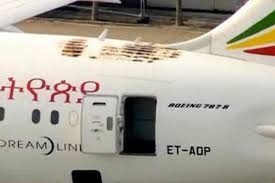The jury seems divided between those who see Boeing’s 787 as a plane experiencing teething problems or an aircraft that is “doomed”. The media headlines have described the plane as “plagued”, and even “troubled”.
This week, US aviation regulator, The Federal Aviation Administration (FAA) published an airworthiness directive advising all carriers to remove Honeywell emergency locator transmitters (ELT) from their 787s. Last week, the FAA suggested airlines should inspect the units on their 787s for pinched wires in the casing and/or evidence of heat or moisture.
United Airlines is the only US carrier currently flying the 787, so is the only one governed by the FAA action. The other 12 airlines flying the plane will be impacted by their own regulators. As a result of investigations United Airlines found a pinched wire in one of its emergency beacons and Japan’s ANA discovered a damaged wire in two of its beacons. ANA have removed the beacons from seven of their domestic 787s.
The UK Air Accidents Investigation Branch (AAIB) said last week that the Honeywell maunfactured emergency beacon was the likely source of the fire on an Ethiopian Airlines at Heathrow on July 12 They called for the device to be turned off but said it did not know exactly how the fire started.
The Investigators are determining if condensation on the plane may have seeped into the ELT triggering a short circuit in the unit’s battery. While condensation is normal on many aeroplanes, the 787 has a higher level of humidity to provide greater passenger comfort.Because water conducts electricity, higher moisture levels could increase the possibility of short circuits. Long term exposure to moisture can lead to corrosion on electrical wires and batteries.
Investigators are also considering the impact of the three month grounding on the aircraft. The Ethiopian Airlines plane sat outside in hot sun.
The ELT has been installed on all sixty eight of the 787s in operation. It is not required by US aviation regulations but mandated by other jurisdictions. The beacons have been installed in different parts of the plane, depending on both airline preference and regulations in its home country. The AAIB noted that there was no equipment to detect or suppress fire in the area where the blaze occurred.
Boeing has confirmed it is discussing with Ethiopian Airlines about repairs to the plane which has extensive damage in its rear and a scorched outer skin on the fuselage just in front of the vertical tail fin. This will be the first repair job on a 787 and airlines will no doubt be interested in how long it will take and how much it will cost to fix the carbon-fibre composite fuselage.
I had been wondering if they would repair at all or if the plane may be quietly replaced by Boeing. I wonder how Ethiopian passengers would feel about flying on the third 787 in the world to catch on fire. I continue to wonder about how any passenger feels about flying on a 787.



Just flew on one from Houston to Chicago, and would do it again in a heartbeat. Every plane has kinks to work out and I feel Boeing did its due diligence (and then some), especially after the battery issues and with its battery soution.
I flew on QR’s 787 a couple weeks after they came back into operation from the battery incident. Flew a short DXB-DOH r/t.
At the time I felt fine flying the 787 as I figured Boeing have ironed out the issues. Now however, I find myself avoiding flights using the 787.
I feel Boeing is only being reactive to issues that crop up and not being pro-active in further testings, then fixing issues before they cause a problem.
Boeing has successfully driven me away, although I was willing to give them a 2nd chance, but for now wont givem a 3rd chance.
At this point I won’t fly on a 787. I’ll wait at least 2 more years before even considering it.
I’m not getting on it. No way!
Way too many new technologies on this aircraft, I will forgo the beta-test opportunity thank you very much. I would not fly one by choice, and would request switchover to another aircraft if one turned up at my gate due to equipment change.